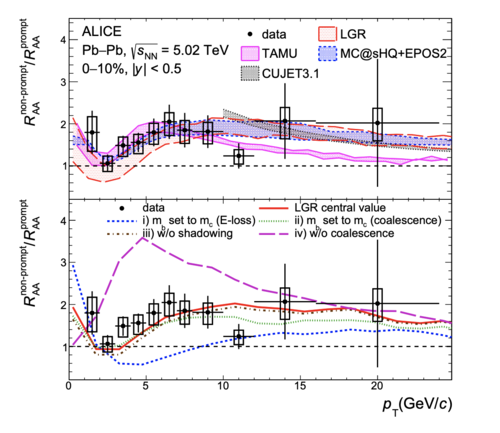
Beauty quarks, which are produced in the first instants of heavy-ion collisions, are an ideal probe to investigate the microscopic interactions in the quark-gluon plasma (QGP). While at high momenta they lose energy, mainly via radiative processes, at low momenta, their propagation through the medium is described as a diffusion process, occurring via multiple low-energy-transfer interactions and favoring their participation in the collective expansion of the system. Because of the larger mass, beauty quarks are expected to radiate less gluons (dead cone effect) and to diffuse less than charm quarks.
The nuclear modification RAA of D0 mesons from beauty-hadron decays (non-prompt D0) was measured down to transverse momentum pT = 1 GeV/c in Pb-Pb collisions at 5.02 TeV and compared to that of prompt D0 mesons (from charm quark hadronization). Non-prompt D0 mesons exhibit a lower suppression than prompt D0 mesons (non-prompt / prompt RAA > 1) in the pT interval, 4-10 GeV/c. The results are well described by models that include both collisional and radiative energy loss processes and quark recombination in addition to fragmentation as a hadronisation mechanism. The low pT-reach and good precision of the measurement allowed to extrapolate the measured spectra down to pT=0, verifying binary scaling of beauty production with about 20% uncertainty.
The figure shows the non-prompt to prompt D0 RAA ratio as a function of pT in the 0-10% centrality class and compared to predictions of different models and to variations of the LGR calculation, aimed at testing the sensitivity of the ratio to different effects.
Mass matters when quarks cross a quark–gluon plasma
Further reading:
ALICE Collaboration 2022 https://arxiv.org/abs/2202.00815
